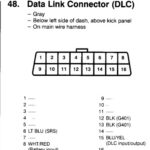Understanding your Ford’s diagnostic trouble codes (DTCs) can be challenging. This guide breaks down common Ford Obd2 Acronyms, empowering you to better understand your vehicle’s health and maintenance needs. Knowing these terms will help you communicate effectively with technicians and potentially save on diagnostic costs.
Essential Ford OBD2 Acronyms Explained
Ford vehicles, like all OBD2 compliant cars, use a standardized system for diagnostics. However, certain acronyms and their applications can be specific to Ford. Let’s delve into some key terms:
Communication Protocols:
- J1850PWM (Pulse Width Modulated): This is the primary communication protocol used in Ford domestic cars and light trucks. It’s crucial for your scan tool to support this protocol to communicate effectively with your Ford’s onboard computer.
- CAN (Controller Area Network): While more common in newer vehicles, some Ford models utilize CAN for high-speed data transfer between various modules.
- DLC (Data Link Connector): The standardized 16-pin connector found in your Ford, typically located under the dashboard on the driver’s side, used to connect a scan tool.
Computer Modules:
- PCM (Powertrain Control Module): The central computer in your Ford controlling engine and transmission functions. It monitors various sensors and adjusts parameters to optimize performance and emissions.
- ECM (Engine Control Module): In some Ford models, the ECM may be a separate module focusing solely on engine management. This term is often used interchangeably with PCM.
- VCM (Vehicle Control Module): This module oversees a wider range of vehicle functions beyond the powertrain, including anti-lock brakes and other body systems.
Sensors and Components:
- DPFE (Differential Pressure Feedback EGR sensor): A crucial component in Ford’s Exhaust Gas Recirculation (EGR) system, measuring the pressure difference across the EGR valve to ensure proper operation. A malfunctioning DPFE can lead to increased emissions and poor engine performance.
- MAF (Mass Air Flow): The MAF sensor measures the amount of air entering the engine, crucial for calculating the correct fuel mixture.
- HO2S (Heated Oxygen Sensor): Ford vehicles utilize one or more HO2S sensors to monitor oxygen levels in the exhaust stream, enabling the PCM to adjust the air/fuel ratio for optimal combustion.
- IAT (Intake Air Temperature): Measures the temperature of the air entering the engine. This information helps the PCM adjust fuel delivery and ignition timing for optimal performance.
Diagnostic Terms:
- DTC (Diagnostic Trouble Code): A standardized five-digit code indicating a specific fault detected by the OBD2 system. Understanding DTCs is crucial for diagnosing and repairing issues.
- MIL (Malfunction Indicator Light): Commonly known as the “Check Engine Light,” the MIL illuminates when the OBD2 system detects a fault that could impact emissions.
Understanding Ford-Specific DTCs
While generic OBD2 codes apply across all makes and models, Ford also utilizes manufacturer-specific codes. These codes provide more detailed information about issues specific to Ford systems and components. Consulting a Ford-specific repair manual or online resource can help you decipher these codes.
Beyond the Basics: Deepening Your Ford OBD2 Knowledge
This overview covers fundamental Ford OBD2 acronyms. For a deeper understanding, consider exploring resources like:
- Ford service manuals: These manuals offer detailed information about your specific Ford model, including detailed explanations of diagnostic procedures and trouble codes.
- Online forums and communities: Connect with other Ford owners and technicians to share knowledge and troubleshooting tips.

